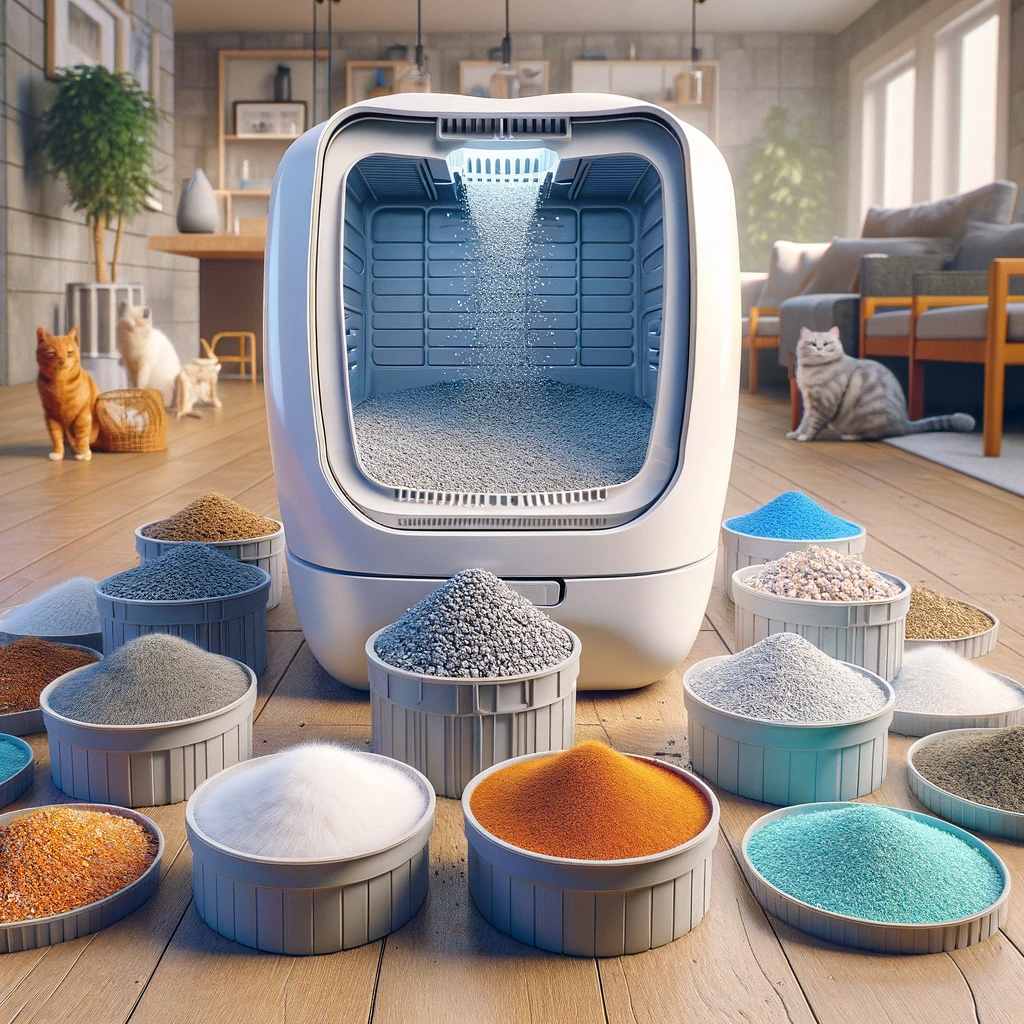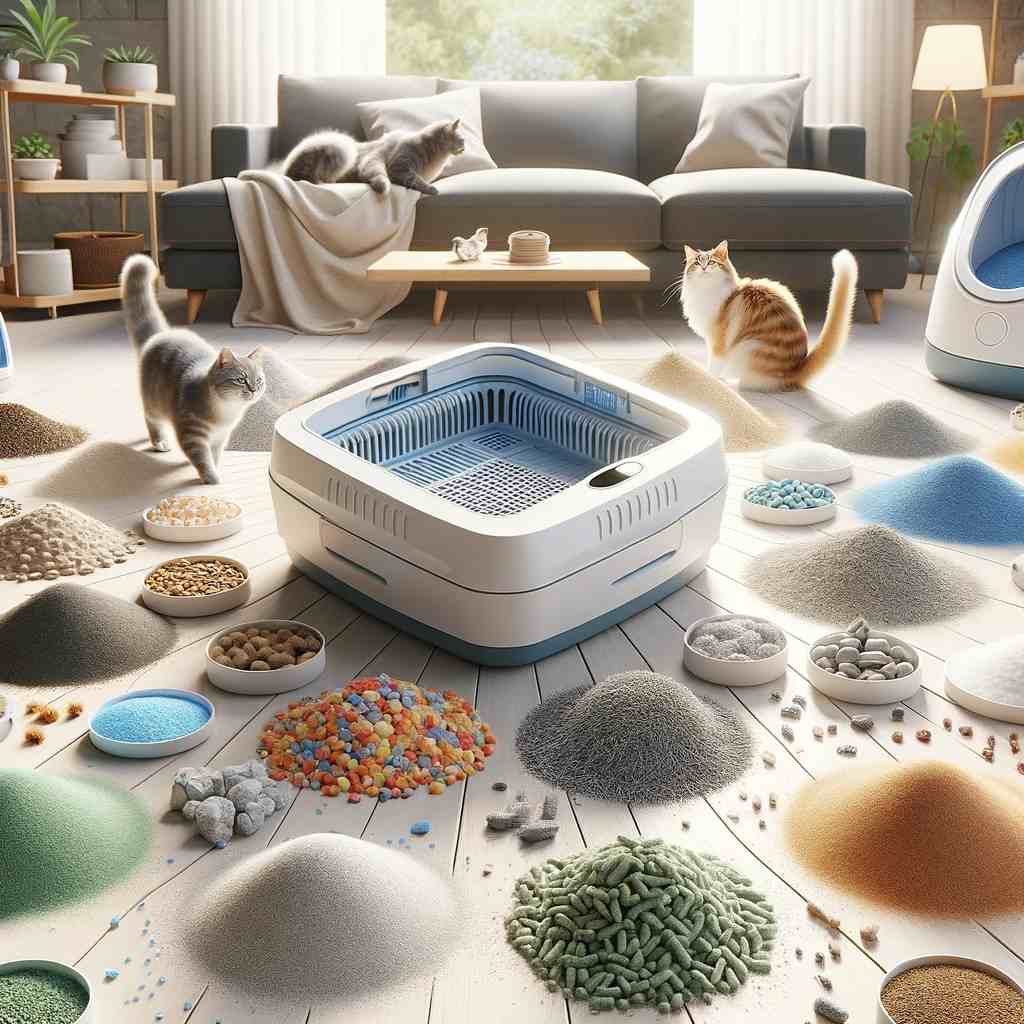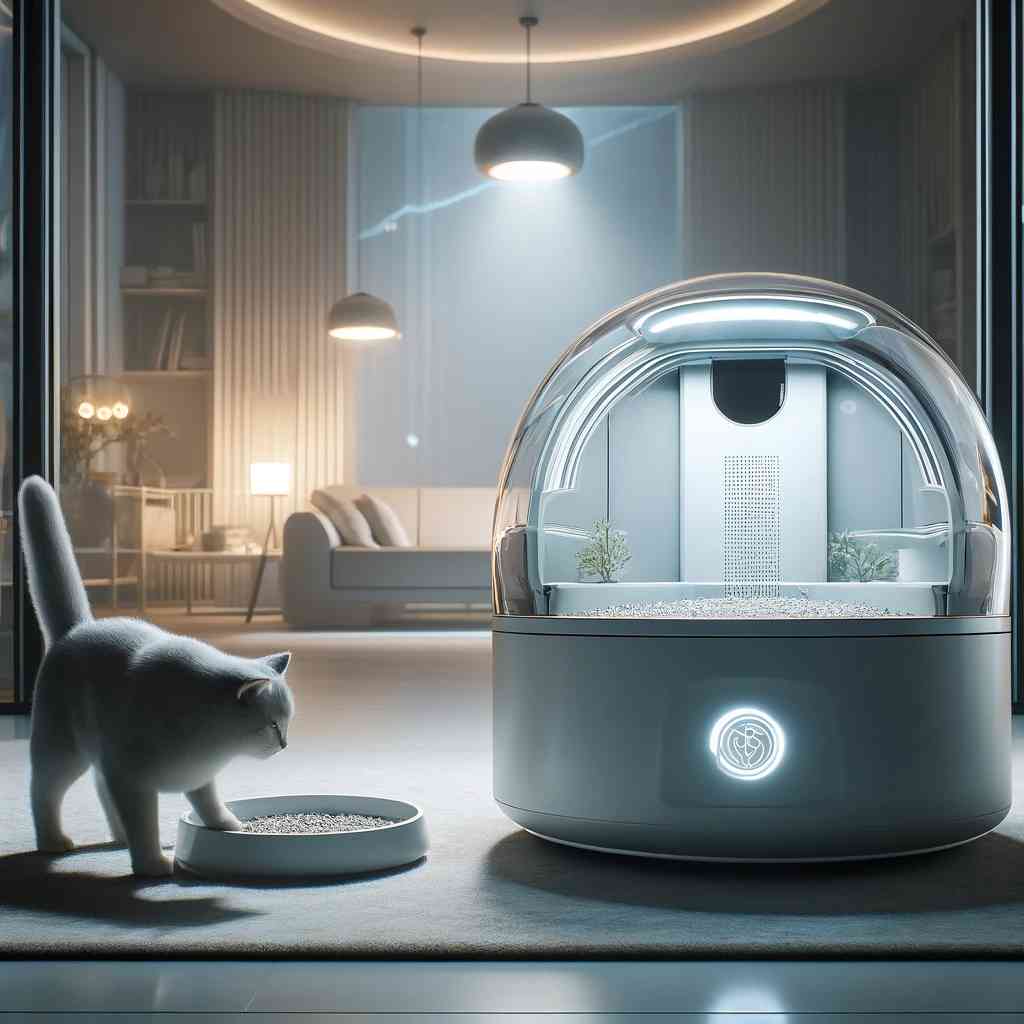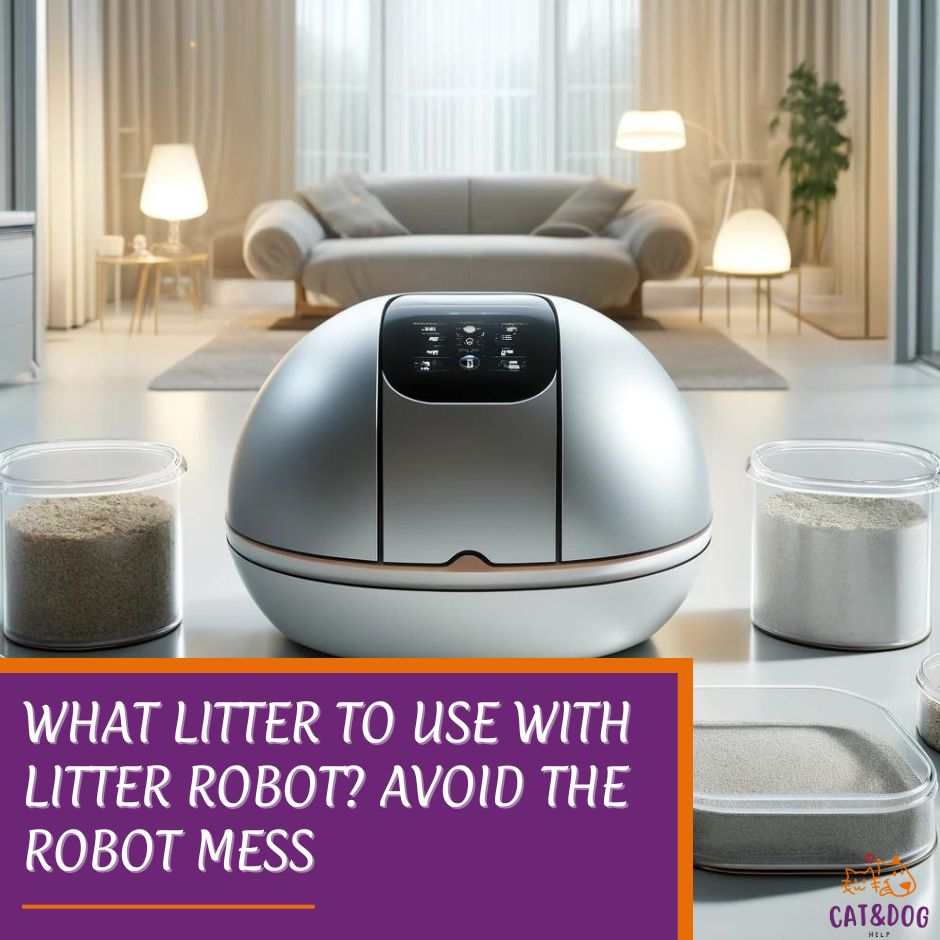Wondering what litter to use with Litter Robot? You’re not alone.
It’s no fun stepping on stray litter, and the Litter Robot, an automated, self-cleaning litter box, is a game changer for keeping your home clean and odor-free. (1)
However, selecting the right litter is crucial; it’s the difference between a well-oiled machine and a mucky mishap.
The right litter not only keeps your furry friend comfortable but also ensures the Litter Robot operates effectively and efficiently.

Choosing the wrong type can lead to more messes and malfunctions than you bargained for.
To avoid this, you’ll need a litter that’s compatible with the mechanics of the Litter Robot. High-quality clumping litter typically works best, as it allows for easy separation and disposal of waste. (2)
But there’s more to consider: dust levels, tracking, scent, and even environmental impact are all important factors. (3)
Beyond that, you might be curious about which specific brands stand out, which ones to avoid, and how to strike that perfect balance between performance and eco-friendliness.
Key Takeaways
- Clumping litter is usually the best choice for the Litter Robot to ensure proper functionality.
- Consider dust levels, tracking, and scent when selecting litter, as well as environmental impact.
- Brand compatibility with the Litter Robot is important for optimal performance and minimal mess.
What Litter to Use With Litter Robot: Comprehensive Review of Litter Types
Clumping Clay Litter
Ever noticed how some litter makes clean-up a breeze? That’s because clumping clay litter is designed to form tight clumps, which the Litter Robot can easily scoop away. Here’s a quick peek at why it’s a favorite:
- Solid Clumps: The clumping action seals in moisture, making the waste easy to remove.
- Consumer Favorites: Popular brands like Dr. Elsey’s Ultra and Arm & Hammer Slide garner high praise for their clumping prowess.
Users often rave about how heavy-duty clumping litter maintains a cleaner environment for their feline friends.
Biodegradable and Eco-Friendly Options
If you’re leaning green, biodegradable litters such as corn, wheat, and walnut shells are kind to Mother Earth and your kitty’s paws.
- Corn Litter: Absorbs odors well, and the texture is soft for delicate paws. (4)
- Wheat Litter: It’s flushable and, like corn, clumps for easy scooping. (5)
- Walnut Shells: Their natural fibers excel in odor control and clumping. (6)
When considering performance in a Litter Robot, these options are commendable, though they may not clump as firmly as clay.
Silica Gel and Crystal Litter
Curious about those tiny crystals? Silica gel litters are non-clumping marvels that trap moisture and lock away odors.
- Moisture Lock: They can hold a lot of liquid, which helps keep the rest of the litter dry.
- Odor Control: Silica is a champ at minimizing nasty smells.
However, in the Litter Robot, their non-clumping nature can lead to less efficient clean cycles as they may not be sifted out as effectively. Still, they are a hypoallergenic option that’s worth consideration.
Weighing the pros and cons will guide you to the perfect litter for your robotic pal. Whether you prefer clumping efficiency or eco-conscious materials, there’s a litter that meets your needs.
Just remember, no matter what you choose, your kitty’s going to thank you with purrs aplenty!
Detailed Technical Insights

Mechanical Compatibility
First up, granule size matters.
- Too large, they might not pass through the sieve, leaving you with a less-than-clean litter space.
- Too small, they could slip through and trigger unnecessary cycling, or worse, clog moving parts.
Aim for a medium-grain, clumping litter! Preferably, granules should be about 1/16″ to 1/2″ in diameter for optimal performance.
Now, what about material?
- Clay-based clumping litters are a popular choice because they:
- Clump effectively around waste for easy removal.
- Are heavy enough not to stick to the waste drawer.
- Don’t easily stick to your kitty’s paws, helping keep the area tidy.
Impact on Sensors and Mechanics
Your Litter Robot is quite the clever device with sensors and moving parts working in harmony.
- Clumping litter works in tandem with the sensors, telling the robot when to cycle.
- Non-clumping materials could confuse the sensors, causing a rebellious robot that either overworks or slacks off.
Additionally, if the litter produces a lot of dust, sensors might get clogged, leading to a sad robot and potentially a smelly situation.
To sum it up, think of your Litter Robot as a discerning cat—it has a taste for litters that make its job easy and keeps its inner workings purring!
Keep this compatibility guide in mind and both you and your furry friend will be on your way to a clean and happy litter experience.
Practical User Experience

Day-to-Day Maintenance:
- Clumped vs. Non-Clump: Your Litter-Robot loves clumping litter. Why? Because it makes scooping a breeze. Non-clumping litter tends to stick around, causing more frequent cleanouts.
Stick with a strong clumping formula to save time and effort. - Biodegradable Options: Plant-based litters are fantastic for easy disposal and are Litter-Robot-friendly. Plus, they’re kind to the planet!
Real User Tips and Experiences:
- “I switched to a clumping clay litter and haven’t looked back. My cleaning time halved!” – Jane, Litter-Robot User
- “Unscented litters worked wonders for my asthmatic cat, and the Litter-Robot handled it perfectly.” – Alex, Cat Enthusiast
Let’s Break It Down:
| Consideration | Why It Matters |
|---|---|
| Litter Type | Clumping is preferred, easy to scoop. |
| Material | Biodegradable is great for the environment, and robots! |
| Odor Control | Clumping is preferred, and easy to scoop. |
| Dust Levels | Low dust options for respiratory health. |
Cats, like us, prefer a clean place to do their business. By choosing the right litter, you’ll not only make your pet happy but also streamline your cleaning routine.
Embrace the change and witness a sigh of relief from your Litter-Robot. Keep these tips handy and enjoy the bliss of a clean litter zone!
Litter Brands Tested and Reviewed
Arm & Hammer Litters
- Performance in Automatic Litter Boxes: Clumps well and reduces waste sticking to the sides.
- User Reviews and Ratings: Often praised for its odor control and dust-free formula.
Ever found yourself sniffing and not in a good way? Arm & Hammer might be your nose’s new best friend with their baking soda-infused litter.
Fresh Step and Purina Products
- Compatibility with Litter Robot Models: Highly compatible, with minimal tracking.
- Consumer Feedback: Users enjoy its clumping capability, though some report a stronger scent.
Want to keep cleanup to a minimum? Fresh Step and Purina may just make your day with less stray litter around the house.
Specialty Litters
- Thinking of going natural or hypoallergenic? Specialty litters enter the spotlight here.
Dr. Elsey’s and World’s Best Cat Litter
- Advantages for Specific Litter Robot Models: Dr. Elsey’s is heavy, reducing tracking, while World’s Best offers biodegradable options.
If you care about eco-friendly products, World’s Best might make you feel as warm and fuzzy inside as when your kitty purrs.
Understanding Litter Robot Mechanics and Compatibility

Factors Affecting Litter Performance in Automatic Boxes
Clumping Ability:
- Critical: Only clumping litter allows for the efficient separation of waste.
- Why it matters: Non-clumping litter can get stuck, impeding the sifting process.
Dust Production:
- Low-Dust Formulas: They’re a breath of fresh air—literally.
- Impact: Reduces the mess and potential respiratory discomfort for you and your furry friend.
Odor Control:
- Essential: A good litter neutralizes odors, keeping your home smelling fresh.
- Options: Look for litters with added baking soda or charcoal for that extra odor-fighting punch. (7)
Check out this quick reference for litter choice:
| Feature | Importance | Notes |
|---|---|---|
| Clumping Ability | High | Must-have for clean sifting |
| Dust Production | Low to Medium | Low-dust options to keep area clean |
| Odor Control | High | Prevents bad smells from lingering |
So, while you’re chatting with your cat about their day, remember that picking the right litter ensures their comfort and the peak performance of your Litter-Robot.
Keep things clumping, clean, and fresh—your nose (and your robot) will thank you!
Balancing Performance with Environmental Concerns

Eco-Friendly Litter Choices:
- Recycled Paper: It’s dust-free and highly absorbent. Plus, you’re giving new life to yesterday’s news!
- Wood Pellets: They’re natural and biodegradable, leaving behind a pine-fresh scent.
Are you wondering if these eco-warriors can keep up in tech-savvy litter boxes? You bet they can! Here’s a quick rundown:
- Performance:
- Absorbency: Both recycled paper and wood pellets provide excellent moisture absorption.
- Odor Control: Natural wood pellets often come with a pleasant smell, combatting odors effectively.
- Dust Generation: Minimal with both options, keeping both your Litter Robot and your lungs happy.
- Absorbency: Both recycled paper and wood pellets provide excellent moisture absorption.
- Environmental Impact:
- Biodegradability: These materials break down quickly and can even be composted in some cases.
- Renewable Resources: Wood pellets are made from sustainably sourced wood, and recycled paper reduces waste.
- Biodegradability: These materials break down quickly and can even be composted in some cases.
The Bottom Line: You don’t have to sacrifice performance for planet-friendliness.
With these options, you can maintain a fuss-free Litter Robot while supporting sustainability. Isn’t that a win-win situation?
Quick Recap

Wondering what litter works best with your Litter-Robot? Let’s break it down:
- Clumping Clay Litter: Great for odor control and easy scooping, but can vary in dust production. How much tidying up are you willing to do?
- Biodegradable Litters: Eco-friendly and often low in dust, these include varieties like wood, corn, and wheat. Are you and your furry pal leaning towards a more natural choice?
- Silica Gel Crystals: Superb for moisture absorption and generally low maintenance. Does the prospect of less frequent changing appeal to you?
- Recycled Paper Litter: Soft and dust-free, ideal for sensitive paws and noses. Could this be the gentle choice for your feline friend?
Here’s how to gauge:
| Litter Type | Dust Level | Maintenance | Ecological Impact |
|---|---|---|---|
| Clumping Clay | Varies | Moderate | Lower |
| Biodegradable | Low to None | Variable | Higher |
| Silica Gel Crystals | Low | Low | Moderate |
| Recycled Paper | None | High | Higher |
Are you looking for convenience, or does sustainability tick your boxes?
Your household environment plays a big role, too—think about your cleaning schedule and your pet’s litter kicking habits.
And remember, your comfort and your cat’s happiness are your guideposts in this litter-choosing journey.
Happy scooping!
Frequently Asked Questions

What are the best clumping cat litters to use in a Litter-Robot?
You’ll want to find a clumping litter that forms tight, hard clumps quickly.Fast-clumping litters made from clay, like Dr. Elsey’s Ultra, are often preferred by Litter-Robot users for their efficient sifting and low tracking.
Is it possible to use crystal cat litters with the Litter-Robot, and which are recommended?
Yes, crystal cat litters can be used in your Litter-Robot.Brands such as Fresh Step Crystals are designed to be low-dust and offer good odor control, which can be a smart choice for your device.
Can biodegradable litters like pine or wheat work effectively in the Litter-Robot?
Biodegradable litters like those made from pine or wheat are an eco-friendly option, but they must be clumping to work in your Litter-Robot. Look for products like sWheat Scoop, which offer the necessary clumping action for the robot’s mechanism.
How does the type of litter affect the maintenance of the Litter Robot?
The litter type influences how often you’ll need to clean and refill your Litter-Robot. Highly absorbent and low-dust litters tend to keep the device cleaner, longer, while non-clumping or lighter litters might require more frequent attention.
Are there any litters that should be avoided in the Litter Robot?
Avoid non-clumping litters and those with large pellets as they don’t work well with the Litter-Robot’s sifting system.Also, steer clear of litters that create significant dust, which can clog the sensors.
What should I avoid in a cat litter to ensure it doesn’t damage my Litter-Robot?
To ensure the longevity of your Litter-Robot, avoid litters that are overly sticky, as they can gum up the workings.Also, litters that produce a lot of dust can interfere with the unit’s sensors.
Can I mix different types of litter in the Litter Robot?
While you can mix different types of litter, it’s not recommended. Mixing litters can alter the consistency needed for the Litter-Robot to operate correctly. This can potentially lead to performance issues.It’s best to stick to one type that you know works well.


